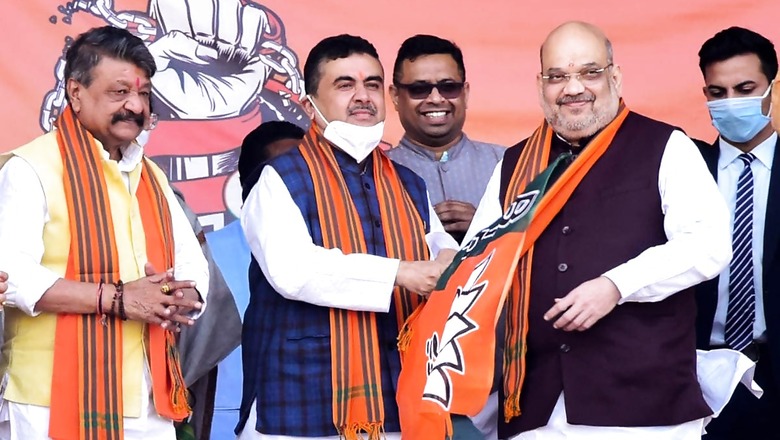
views
Beni Prasad Verma was a career socialist who became the telecom minister in the 13-party United Front government in 1996 at the Centre. He was also the de facto number 2 to Mulayam Singh Yadav in the Samajwadi Party.
A decade or so later, Verma quit the SP to join Congress. He won the 2009 elections to become a minister of state in the Manmohan Singh government. Mulayam Singh called to congratulate Beni Babu and rubbed it into his former colleague for accepting an MoS rank when he had already been a cabinet minister a decade back.
Later that evening, while speaking to a small group of journalists, Verma referred to the congratulatory call from the SP chief while delving into the circumstances which led to his entry into the Congress.
Till then, it was a general belief among political observers that Amar Singh had schemed to drive a wedge between Mulayam and Verma.
Verma had a completely different take on this subject. He felt that Amar Singh’s rise was engineered by the SP chief himself. The aim was to contain Verma’s influence in the party.
The reason being that Beni Babu considered himself as the natural successor to Mulayam in Uttar Pradesh politics. The pehalwan from Etawah had learnt the ropes of his trade the hard way. He fought a pitched battle with Chaudhary Charan Singh’s son— the US-returned computer engineer Ajit Singh who had also laid claim to his father’s political legacy.
Then push came to shove in the 1989 UP assembly polls. The Janata Dal won a majority. VP Singh backed Ajit Singh for chief ministership. The numerically powerful castes like Yadavs and Kurmis mobilised MLAs to install Mulayam Singh as the chief minister. Beni Verma, a Kurmi leader from central UP, backed Mulayam Singh vis-à-vis
a Jat from western UP.
Ajit Singh could never recover from this setback as his party and influence shrunk to half a dozen districts adjoining Delhi. In Lucknow, Yadav took over the reins of leadership of land proprietary intermediary castes.
But Mulayam Singh, quite unlike Charan Singh, was sharp enough to foresee a leadership challenge to Yadav domination. The push would come sooner rather than later. And that challenge would have most likely come from the community standing next in line— the Kurmis.
By forcing Verma out of the party, Mulayam tried to nip any potential dissidence in the bud. Verma joined the Congress but could never become the chief minister of UP. Later, he returned to the SP and was nominated to the Rajya Sabha. He died this year at the age of 79.
In neighbouring Bihar, Nitish Kumar learnt his lessons from Beni Babu’s political missteps. He successfully marshalled non-Yadav other backward classes (OBCs) and joined hands with the BJP to commandeer natural transition of power from Yadavs to Kurmis to win four consecutive elections.
Kumar, while alienating Yadavs among the OBCs, continually defanged potential threats to leadership from backward communities who languished at the lower end of the Mandal block. Upendra Kushwaha is a test case in this conflict.
In Bengal too, Suvendu Adhikari’s defection to the BJP seems to be borne out of the unresolved leadership issues in the Trinamool Congress. Mamata Banerjee remains the undisputed leader of the party. But the disruption now is triggered by the moot question: who will be the inheritor of the political space being occupied by the West Bengal chief minister.
Adhikari is BJP’s biggest catch from Mamata’s flock after Mukul Roy’s defection ahead of the 2019 Lok Sabha polls. But unlike Roy, who remains an out-and-out organisational man, Adhikari is also a mass leader in his own right. He is ambitious, and comes from a powerful political family in Medinipur. He was instrumental in organising the Nandigram movement which led to the collapse of three decades of Left Front rule in West Bengal. Overall, he had displayed all traits to lay claim to the state’s leadership after Mamata Banerjee.
A few years ago there were reports of Adhikari meeting a very senior Congress leader in Delhi. He was accompanied by an aggressive state leader of the Congress who is seen as a proponent of Left-Congress alliance in the state. These discussions, however, could not be taken to their logical conclusion.
And then came Mamata’s nephew Abhishek Banerjee, whose influence and control both on the party and government is on the rise. The nephew roped in poll strategist Prashant Kishor and team to bolster the party’s prospects.
Adhikari had three options. He could have either waited and watched like Telangana chief minister K Chandrashekar Rao’s nephew T Harish Rao. He could have rebelled and formed an alternative political outfit as did Mamata Banerjee when she was stifled for space by Congress stalwarts in Bengal. But that would have been a long haul with no guarantee of success. Bijoy Mohapatra, a claimant to Biju Patnaik’s legacy, learnt it the hard way.
Adhikari, like Himanta Biswa Sarma of Assam, chose the third path. He joined hands with the party in power at the Centre. To survive and launch another leadership challenge some other day.
This is unadulterated power play. The grit and the grind of the very best in the job is at display.
Ideology, etc, are mere accoutrements in a contest for political succession.
Read all the Latest News, Breaking News and Coronavirus News here




















Comments
0 comment